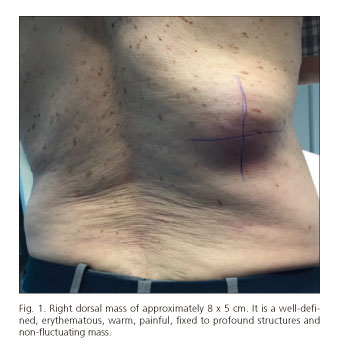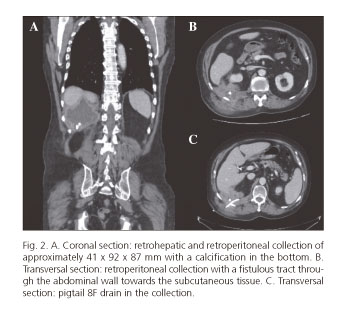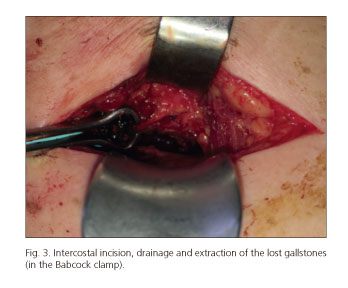Meu SciELO
Serviços Personalizados
Journal
Artigo
Indicadores
-
 Citado por SciELO
Citado por SciELO -
 Acessos
Acessos
Links relacionados
-
 Citado por Google
Citado por Google -
 Similares em
SciELO
Similares em
SciELO -
 Similares em Google
Similares em Google
Compartilhar
Revista Española de Enfermedades Digestivas
versão impressa ISSN 1130-0108
Rev. esp. enferm. dig. vol.109 no.6 Madrid Jun. 2017
PICTURES IN DIGESTIVE PATHOLOGY
Dorsal inflammatory mass secondary to lost stones after laparoscopic cholecystectomy
Tumoración dorsal inflamatoria secundaria a litiasis perdidas tras colecistectomía laparoscópica
Cristina Pineño-Flores, Juan José Segura-Sampedro, Rafael Morales-Soriano and Francesc Xavier González-Argente
Department of General Surgery and Digestive Diseases. Hospital Universitario Son Espases. Palma de Mallorca, Spain
Case report
We report the case of a 73-year-old man with a medical history of hypertension, diabetes, chronic kidney failure and laparoscopic cholecystectomy in 2013. He was admitted to the Emergency Room in 2016 with a large dorsal abscess of three months evolution without any other symptoms. On physical examination, he had an 8 x 5 cm well defined erythematous, warm, painful, fixed to profound structures and non-fluctuating mass (Fig. 1). The test blood highlighted a 26.80 mg/dl concentration of C-reactive protein (CRP). The computed tomography (CT) scan revealed a retroperitoneal abscess extended to the last ribs and subcutaneous tissue with a calcification in the bottom of the collection (Fig. 2). The surgical notes detailed an incidental gallbladder perforation; subsequently, it was diagnosed as an abscess due to lost lithiasis. We decided to admit the patient for broad-spectrum antibiotic treatment. An interventionist radiologist placed a drain as a guide for the surgical procedure, with extraction of the lost stones and drainage of the collection (Fig. 3).
Discussion
The most frequent intraabdominal complication after lost stones are abscesses, which account for 65% of complications (1). The main risk factors are: old age, male gender, surgical difficulty, leakage of lithiasis of more than 1.5 cm or more than 15 stones, perihepatic location and pigmented gallstones (1-3). The diagnosis requires a high index of suspicion. Cases of spontaneous expulsion of the stones have been reported, but most of them require a definitive treatment via drainage of the abscess and removal of the gallstones in order to prevent recurrences in the future.
References
1. Morales. R, Noguera J, Cuadrado A, et al. Absceso intraabdominal secundario a litiasis perdidas postcolecistectomía. Casos Clínicos Cirugía General 2010;2(3). [ Links ]
2. Moga D, Perisaun S, Popentiu A, et al. Right retroperitoneal and subhepatic abscess; late complications due to spilled stones during laparoscopic cholecystectomy - Case report. Chirurgia 2016;111:67-70. [ Links ]
3. Pazouki A, Abdollahi A, Bahar MM, et al. Evaluation of the incidence of complications of lost gallstones during laparoscopic cholecystectmy. Surg Laparosc End Percutan Tech 2014;24:213-5. DOI: 10.1097/SLE.0b013e31828fc09e. [ Links ]











 texto em
texto em 




